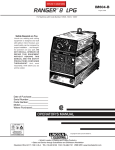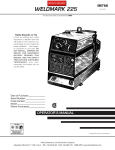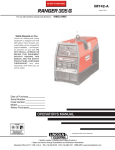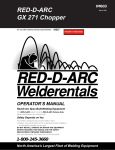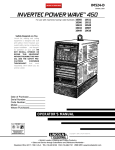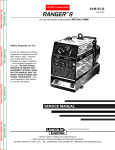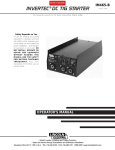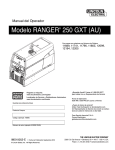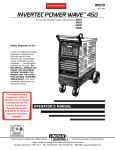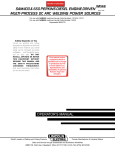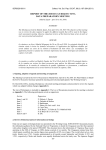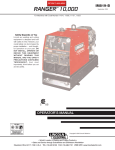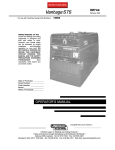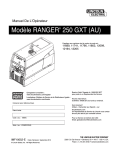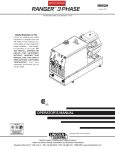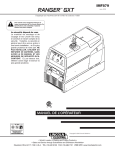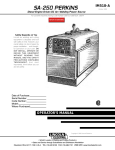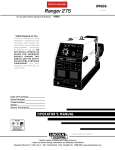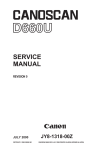Download Lincoln Electric RANGER IM612 User's Manual
Transcript
RETURN TO MAIN MENU IM612 RANGER ™ 8 + DIESEL For use with machines having Code Numbers: April, 1998 10533 Safety Depends on You Lincoln arc welding and cutting equipment is designed and built with safety in mind. However, your overall safety can be increased by proper installation ... and thoughtful operation on your part. DO NOT INSTALL, OPERATE OR REPAIR THIS EQUIPMENT WITHOUT READING THIS MANUAL AND THE SAFETY PRECAUTIONS CONTAINED THROUGHOUT. And, most importantly, think before you act and be careful. RANG ER 8+ DIESE L OPERATOR’S MANUAL World's Leader in Welding and Cutting Products Premier Manufacturer of Industrial Motors • Sales and Service through Subsidiaries and Distributors Worldwide • Cleveland, Ohio 44117-1199 U.S.A. TEL: 216.481.8100 FAX: 216.486.1751 WEB SITE: www.lincolnelectric.com i i SAFETY WARNING CALIFORNIA PROPOSITION 65 WARNINGS Diesel engine exhaust and some of its constituents are known to the State of California to cause cancer, birth defects, and other reproductive harm. The Above For Diesel Engines The engine exhaust from this product contains chemicals known to the State of California to cause cancer, birth defects, or other reproductive harm. The Above For Gasoline Engines ARC WELDING CAN BE HAZARDOUS. PROTECT YOURSELF AND OTHERS FROM POSSIBLE SERIOUS INJURY OR DEATH. KEEP CHILDREN AWAY. PACEMAKER WEARERS SHOULD CONSULT WITH THEIR DOCTOR BEFORE OPERATING. Read and understand the following safety highlights. For additional safety information, it is strongly recommended that you purchase a copy of “Safety in Welding & Cutting - ANSI Standard Z49.1” from the American Welding Society, P.O. Box 351040, Miami, Florida 33135 or CSA Standard W117.2-1974. A Free copy of “Arc Welding Safety” booklet E205 is available from the Lincoln Electric Company, 22801 St. Clair Avenue, Cleveland, Ohio 44117-1199. BE SURE THAT ALL INSTALLATION, OPERATION, MAINTENANCE AND REPAIR PROCEDURES ARE PERFORMED ONLY BY QUALIFIED INDIVIDUALS. FOR ENGINE powered equipment. 1.h. To avoid scalding, do not remove the radiator pressure cap when the engine is hot. 1.a. Turn the engine off before troubleshooting and maintenance work unless the maintenance work requires it to be running. ____________________________________________________ 1.b. Operate engines in open, well-ventilated areas or vent the engine exhaust fumes outdoors. ____________________________________________________ 1.c. Do not add the fuel near an open flame welding arc or when the engine is running. Stop the engine and allow it to cool before refueling to prevent spilled fuel from vaporizing on contact with hot engine parts and igniting. Do not spill fuel when filling tank. If fuel is spilled, wipe it up and do not start engine until fumes have been eliminated. ____________________________________________________ 1.d. Keep all equipment safety guards, covers and devices in position and in good repair.Keep hands, hair, clothing and tools away from V-belts, gears, fans and all other moving parts when starting, operating or repairing equipment. ____________________________________________________ 1.e. In some cases it may be necessary to remove safety guards to perform required maintenance. Remove guards only when necessary and replace them when the maintenance requiring their removal is complete. Always use the greatest care when working near moving parts. ___________________________________________________ 1.f. Do not put your hands near the engine fan. Do not attempt to override the governor or idler by pushing on the throttle control rods while the engine is running. ELECTRIC AND MAGNETIC FIELDS may be dangerous 2.a. Electric current flowing through any conductor causes localized Electric and Magnetic Fields (EMF). Welding current creates EMF fields around welding cables and welding machines 2.b. EMF fields may interfere with some pacemakers, and welders having a pacemaker should consult their physician before welding. 2.c. Exposure to EMF fields in welding may have other health effects which are now not known. 2.d. All welders should use the following procedures in order to minimize exposure to EMF fields from the welding circuit: 2.d.1. Route the electrode and work cables together - Secure them with tape when possible. 2.d.2. Never coil the electrode lead around your body. 2.d.3. Do not place your body between the electrode and work cables. If the electrode cable is on your right side, the work cable should also be on your right side. 2.d.4. Connect the work cable to the workpiece as close as possible to the area being welded. ___________________________________________________ 1.g. To prevent accidentally starting gasoline engines while turning the engine or welding generator during maintenance work, disconnect the spark plug wires, distributor cap or magneto wire as appropriate. 2.d.5. Do not work next to welding power source. Mar ‘95 ii ii SAFETY ELECTRIC SHOCK can kill. 3.a. The electrode and work (or ground) circuits are electrically “hot” when the welder is on. Do not touch these “hot” parts with your bare skin or wet clothing. Wear dry, hole-free gloves to insulate hands. 3.b. Insulate yourself from work and ground using dry insulation. Make certain the insulation is large enough to cover your full area of physical contact with work and ground. In addition to the normal safety precautions, if welding must be performed under electrically hazardous conditions (in damp locations or while wearing wet clothing; on metal structures such as floors, gratings or scaffolds; when in cramped positions such as sitting, kneeling or lying, if there is a high risk of unavoidable or accidental contact with the workpiece or ground) use the following equipment: • Semiautomatic DC Constant Voltage (Wire) Welder. • DC Manual (Stick) Welder. • AC Welder with Reduced Voltage Control. 3.c. In semiautomatic or automatic wire welding, the electrode, electrode reel, welding head, nozzle or semiautomatic welding gun are also electrically “hot”. 3.d. Always be sure the work cable makes a good electrical connection with the metal being welded. The connection should be as close as possible to the area being welded. 3.e. Ground the work or metal to be welded to a good electrical (earth) ground. 3.f. Maintain the electrode holder, work clamp, welding cable and welding machine in good, safe operating condition. Replace damaged insulation. 3.g. Never dip the electrode in water for cooling. 3.h. Never simultaneously touch electrically “hot” parts of electrode holders connected to two welders because voltage between the two can be the total of the open circuit voltage of both welders. 3.i. When working above floor level, use a safety belt to protect yourself from a fall should you get a shock. 3.j. Also see Items 6.c. and 8. ARC RAYS can burn. 4.a. Use a shield with the proper filter and cover plates to protect your eyes from sparks and the rays of the arc when welding or observing open arc welding. Headshield and filter lens should conform to ANSI Z87. I standards. 4.b. Use suitable clothing made from durable flame-resistant material to protect your skin and that of your helpers from the arc rays. 4.c. Protect other nearby personnel with suitable, non-flammable screening and/or warn them not to watch the arc nor expose themselves to the arc rays or to hot spatter or metal. FUMES AND GASES can be dangerous. 5.a. Welding may produce fumes and gases hazardous to health. Avoid breathing these fumes and gases.When welding, keep your head out of the fume. Use enough ventilation and/or exhaust at the arc to keep fumes and gases away from the breathing zone. When welding with electrodes which require special ventilation such as stainless or hard facing (see instructions on container or MSDS) or on lead or cadmium plated steel and other metals or coatings which produce highly toxic fumes, keep exposure as low as possible and below Threshold Limit Values (TLV) using local exhaust or mechanical ventilation. In confined spaces or in some circumstances, outdoors, a respirator may be required. Additional precautions are also required when welding on galvanized steel. 5.b. Do not weld in locations near chlorinated hydrocarbon vapors coming from degreasing, cleaning or spraying operations. The heat and rays of the arc can react with solvent vapors to form phosgene, a highly toxic gas, and other irritating products. 5.c. Shielding gases used for arc welding can displace air and cause injury or death. Always use enough ventilation, especially in confined areas, to insure breathing air is safe. 5.d. Read and understand the manufacturer’s instructions for this equipment and the consumables to be used, including the material safety data sheet (MSDS) and follow your employer’s safety practices. MSDS forms are available from your welding distributor or from the manufacturer. 5.e. Also see item 1.b. Mar ‘95 iii iii SAFETY WELDING SPARKS can cause fire or explosion. 6.a. Remove fire hazards from the welding area. If this is not possible, cover them to prevent the welding sparks from starting a fire. Remember that welding sparks and hot materials from welding can easily go through small cracks and openings to adjacent areas. Avoid welding near hydraulic lines. Have a fire extinguisher readily available. 6.b. Where compressed gases are to be used at the job site, special precautions should be used to prevent hazardous situations. Refer to “Safety in Welding and Cutting” (ANSI Standard Z49.1) and the operating information for the equipment being used. 6.c. When not welding, make certain no part of the electrode circuit is touching the work or ground. Accidental contact can cause overheating and create a fire hazard. 6.d. Do not heat, cut or weld tanks, drums or containers until the proper steps have been taken to insure that such procedures will not cause flammable or toxic vapors from substances inside. They can cause an explosion even though they have been “cleaned”. For information, purchase “Recommended Safe Practices for the Preparation for Welding and Cutting of Containers and Piping That Have Held Hazardous Substances”, AWS F4.1 from the American Welding Society (see address above). 6.e. Vent hollow castings or containers before heating, cutting or welding. They may explode. 6.f. Sparks and spatter are thrown from the welding arc. Wear oil free protective garments such as leather gloves, heavy shirt, cuffless trousers, high shoes and a cap over your hair. Wear ear plugs when welding out of position or in confined places. Always wear safety glasses with side shields when in a welding area. 6.g. Connect the work cable to the work as close to the welding area as practical. Work cables connected to the building framework or other locations away from the welding area increase the possibility of the welding current passing through lifting chains, crane cables or other alternate circuits. This can create fire hazards or overheat lifting chains or cables until they fail. 6.h. Also see item 1.c. CYLINDER may explode if damaged. 7.a. Use only compressed gas cylinders containing the correct shielding gas for the process used and properly operating regulators designed for the gas and pressure used. All hoses, fittings, etc. should be suitable for the application and maintained in good condition. 7.b. Always keep cylinders in an upright position securely chained to an undercarriage or fixed support. 7.c. Cylinders should be located: • Away from areas where they may be struck or subjected to physical damage. • A safe distance from arc welding or cutting operations and any other source of heat, sparks, or flame. 7.d. Never allow the electrode, electrode holder or any other electrically “hot” parts to touch a cylinder. 7.e. Keep your head and face away from the cylinder valve outlet when opening the cylinder valve. 7.f. Valve protection caps should always be in place and hand tight except when the cylinder is in use or connected for use. 7.g. Read and follow the instructions on compressed gas cylinders, associated equipment, and CGA publication P-l, “Precautions for Safe Handling of Compressed Gases in Cylinders,” available from the Compressed Gas Association 1235 Jefferson Davis Highway, Arlington, VA 22202. FOR ELECTRICALLY powered equipment. 8.a. Turn off input power using the disconnect switch at the fuse box before working on the equipment. 8.b. Install equipment in accordance with the U.S. National Electrical Code, all local codes and the manufacturer’s recommendations. 8.c. Ground the equipment in accordance with the U.S. National Electrical Code and the manufacturer’s recommendations. Mar ‘95 PRÉCAUTIONS DE SÛRETÉ Pour votre propre protection lire et observer toutes les instructions et les précautions de sûreté specifiques qui parraissent dans ce manuel aussi bien que les précautions de sûreté générales suivantes: Sûreté Pour Soudage A L’Arc 1. Protegez-vous contre la secousse électrique: a. Les circuits à l’électrode et à la piéce sont sous tension quand la machine à souder est en marche. Eviter toujours tout contact entre les parties sous tension et la peau nue ou les vétements mouillés. Porter des gants secs et sans trous pour isoler les mains. b. Faire trés attention de bien s’isoler de la masse quand on soude dans des endroits humides, ou sur un plancher metallique ou des grilles metalliques, principalement dans les positions assis ou couché pour lesquelles une grande partie du corps peut être en contact avec la masse. c. Maintenir le porte-électrode, la pince de masse, le câble de soudage et la machine à souder en bon et sûr état defonctionnement. d.Ne jamais plonger le porte-électrode dans l’eau pour le refroidir. e. Ne jamais toucher simultanément les parties sous tension des porte-électrodes connectés à deux machines à souder parce que la tension entre les deux pinces peut être le total de la tension à vide des deux machines. f. Si on utilise la machine à souder comme une source de courant pour soudage semi-automatique, ces precautions pour le porte-électrode s’applicuent aussi au pistolet de soudage. 2. Dans le cas de travail au dessus du niveau du sol, se protéger contre les chutes dans le cas ou on recoit un choc. Ne jamais enrouler le câble-électrode autour de n’importe quelle partie du corps. 3. Un coup d’arc peut être plus sévère qu’un coup de soliel, donc: a. Utiliser un bon masque avec un verre filtrant approprié ainsi qu’un verre blanc afin de se protéger les yeux du rayonnement de l’arc et des projections quand on soude ou quand on regarde l’arc. b. Porter des vêtements convenables afin de protéger la peau de soudeur et des aides contre le rayonnement de l‘arc. c. Protéger l’autre personnel travaillant à proximité au soudage à l’aide d’écrans appropriés et non-inflammables. 4. Des gouttes de laitier en fusion sont émises de l’arc de soudage. Se protéger avec des vêtements de protection libres de l’huile, tels que les gants en cuir, chemise épaisse, pantalons sans revers, et chaussures montantes. 5. Toujours porter des lunettes de sécurité dans la zone de soudage. Utiliser des lunettes avec écrans lateraux dans les zones où l’on pique le laitier. 6. Eloigner les matériaux inflammables ou les recouvrir afin de prévenir tout risque d’incendie dû aux étincelles. 7. Quand on ne soude pas, poser la pince à une endroit isolé de la masse. Un court-circuit accidental peut provoquer un échauffement et un risque d’incendie. 8. S’assurer que la masse est connectée le plus prés possible de la zone de travail qu’il est pratique de le faire. Si on place la masse sur la charpente de la construction ou d’autres endroits éloignés de la zone de travail, on augmente le risque de voir passer le courant de soudage par les chaines de levage, câbles de grue, ou autres circuits. Cela peut provoquer des risques d’incendie ou d’echauffement des chaines et des câbles jusqu’à ce qu’ils se rompent. 9. Assurer une ventilation suffisante dans la zone de soudage. Ceci est particuliérement important pour le soudage de tôles galvanisées plombées, ou cadmiées ou tout autre métal qui produit des fumeés toxiques. 10. Ne pas souder en présence de vapeurs de chlore provenant d’opérations de dégraissage, nettoyage ou pistolage. La chaleur ou les rayons de l’arc peuvent réagir avec les vapeurs du solvant pour produire du phosgéne (gas fortement toxique) ou autres produits irritants. 11. Pour obtenir de plus amples renseignements sur la sûreté, voir le code “Code for safety in welding and cutting” CSA Standard W 117.2-1974. PRÉCAUTIONS DE SÛRETÉ POUR LES MACHINES À SOUDER À TRANSFORMATEUR ET À REDRESSEUR 1. Relier à la terre le chassis du poste conformement au code de l’électricité et aux recommendations du fabricant. Le dispositif de montage ou la piece à souder doit être branché à une bonne mise à la terre. 2. Autant que possible, I’installation et l’entretien du poste seront effectués par un électricien qualifié. 3. Avant de faires des travaux à l’interieur de poste, la debrancher à l’interrupteur à la boite de fusibles. 4. Garder tous les couvercles et dispositifs de sûreté à leur place. Mar. ‘93 v v Thank You for selecting a QUALITY product by Lincoln Electric. We want you to take pride in operating this Lincoln Electric Company product ••• as much pride as we have in bringing this product to you! Please Examine Carton and Equipment For Damage Immediately When this equipment is shipped, title passes to the purchaser upon receipt by the carrier. Consequently, Claims for material damaged in shipment must be made by the purchaser against the transportation company at the time the shipment is received. Please record your equipment identification information below for future reference. This information can be found on your machine nameplate. Model Name & Number _____________________________________ Code & Serial Number _____________________________________ Date of Purchase _____________________________________ Whenever you request replacement parts for or information on this equipment always supply the information you have recorded above. Read this Operators Manual completely before attempting to use this equipment. Save this manual and keep it handy for quick reference. Pay particular attention to the safety instructions we have provided for your protection. The level of seriousness to be applied to each is explained below: ENGINE SERVICE Please note that the Ruggerini Engine on this machine will be serviced in the United States and Canada by any authorized Deutz Engine Service Center. WARNING This statement appears where the information must be followed exactly to avoid serious personal injury or loss of life. CAUTION This statement appears where the information must be followed to avoid minor personal injury or damage to this equipment. vi TABLE OF CONTENTS Page Installation.......................................................................................................................Section A Technical Specifications .......................................................................................................A-1 Installation Instructions. ........................................................................................................A-2 Location and Ventilation ................................................................................................A-2 Storing ...........................................................................................................................A-2 Stacking ........................................................................................................................A-2 Angle of Operation ........................................................................................................A-2 Lifting.............................................................................................................................A-3 Additional Safety Precautions .......................................................................................A-3 Pre-Operation Engine Service..............................................................................................A-3 Oil ..................................................................................................................................A-3 Fuel ...............................................................................................................................A-4 Battery Connections ......................................................................................................A-4 Spark Arrester ...............................................................................................................A-4 Electrical Connections ..........................................................................................................A-5 Machine Grounding .......................................................................................................A-5 Welding Cable Connections ..........................................................................................A-5 Auxiliary Power Receptacles, Plugs, and Hand-Held Equipment ........................................A-6 Circuit Breakers ....................................................................................................................A-6 Premises Wiring ...................................................................................................................A-6 Operation.........................................................................................................................Section B General Description..............................................................................................................B-1 Design Features ...................................................................................................................B-1 Other Features .....................................................................................................................B-1 Recommended Applications.................................................................................................B-2 Limitations ............................................................................................................................B-2 Additional Safety Precautions .............................................................................................B-2 Controls and Settings ..................................................................................................................B-3 Machine Controls ..........................................................................................................B-3 Engine Operation .................................................................................................................B-5 Before Starting the Engine ............................................................................................B-5 Starting the Engine........................................................................................................B-5 Stoping the Engine ........................................................................................................B-5 Break-In Period .............................................................................................................B-6 Welding Operation................................................................................................................B-6 Welding Process ..................................................................................................................B-7 Stick (Constant Current) Welding..................................................................................B-7 TIG (Constant Current) Welding ...................................................................................B-7 Wire Feed Welding (CV) ...............................................................................................B-7 Summary of Welding Processes and Machine Settings ...............................................B-8 Auxiliary Power.....................................................................................................................B-9 Simultaneous Welding and Power Loads .....................................................................B-9 115 / 230 Volt Dual Voltage Receptacle .....................................................................B-10 115 V Duplex Receptacles ..........................................................................................B-10 Accessories .....................................................................................................Section C General Options / Accessories ..............................................................................C-1 TIG Welding Options / Accessories.......................................................................C-1 Semiautomatic FCAW and MIG Welding Options / Accessories.........................................C-2 Connection Diagrams for Accessories ..................................................................C-3 vii TABLE OF CONTENTS Page Maintenance ....................................................................................................Section D Safety Precautions ................................................................................................D-1 Routine Maintenance.............................................................................................D-1 Engine Adjustments...............................................................................................D-2 Slip Rings ..............................................................................................................D-2 Battery ...................................................................................................................D-2 Engine Maintenance Components ........................................................................D-2 Troubleshooting ..............................................................................................Section E Safety Precautions.................................................................................................E-1 How to Use Troubleshooting Guide.......................................................................E-1 Troubleshooting Guide ..........................................................................................E-2 Wiring Diagram & Dimension Print................................................................Section F Parts List ......................................................................................................P314 Series A-1 A-1 INSTALLATION TECHNICAL SPECIFICATIONS - RANGER 8+ DIESEL (K1632-1) INPUT - DIESEL ENGINE Make/Model Description Speed (RPM) Ruggerini RD 201 Diesel Engine 2 cylinder High Idle 3700 4 Cycle Low Idle 2200 Air Cooled Diesel Full Load 3500 w/Direct Injection Diecast Aluminum Crankcase Displacement Starting System Capacities 51.9 cu. in (851 cc) 12VDC battery Fuel: 9.0 gal. 34.0 L Horsepower Oil: 3.2 Qts. 3.0 L 18.4 HP @ 3600 RPM RATED OUTPUT - WELDER Welding Output Volts at Rated Amps Duty Cycle 25 volts 25 volts 20 volts 100% 100% 100% DC Constant Current 225 amps AC Constant Current 250 amps DC Constant Voltage 200 amps Max. OCV @ 3700 RPM 80 volts RMS OUTPUT - GENERATOR Auxiliary Power 1 9,000 Watts, 60 Hz 80 Amps @ 115 Volts / 40 Amps @ 230 Volts 100 % Duty Cycle PHYSICAL DIMENSIONS HEIGHT WIDTH DEPTH WEIGHT 30.75 in. 19.09 in. 48.12 in. 695 lbs. 781.1 mm 484.9 mm 1222.2 mm 315 Kg. 1. Output rating in watts is equivalent to volt-amperes at unity power factor. Output voltage is within ± 10% at all loads up to rated capacity. When welding, available auxiliary power will be reduced. RANGER 8+ DIESEL A-2 INSTALLATION INSTALLATION INSTRUCTIONS SAFETY PRECAUTIONS A-2 Always operate the RANGER 8+ DIESEL with the case roof on and all machine components completely assembled. This will protect you from the dangers of moving parts, hot metal surfaces, and live electrical devices. WARNING Do not attempt to use this equipment until you have thoroughly read the engine manufacturer’s manual supplied with your welder. It includes important safety precautions, detailed engine starting, operating and maintenance instructions, and parts lists. -----------------------------------------------------------------------ELECTRIC SHOCK can kill. • Do not touch electrically live parts or electrode with skin or wet clothing. • Insulate yourself from work and ground • Always wear dry insulating gloves. -----------------------------------------------------------------------ENGINE EXHAUST can kill. • Use in open, well ventilated areas or vent exhaust outside. -----------------------------------------------------------------------MOVING PARTS can injure. • Do not operate with doors open or guards off. • Stop engine before servicing. • Keep away from moving parts. ------------------------------------------------------------------------ STORING 1. Store the machine in a cool, dry place when it is not in use. Protect it from dust and dirt. Keep it where it can’t be accidentally damaged from construction activities, moving vehicles, and other hazards. 2. Drain the engine oil and refill with fresh 15W40 oil. Run the engine for about five minutes to circulate oil to all the parts. See the MAINTENANCE section of this manual for details on changing oil. 3. Remove the battery, recharge it, and adjust the electrolyte level. Store the battery in a dry, dark place. 4. If the engine is not used for a long period of time, every two to three months run the engine for about five minutes to keep it free from rust. STACKING RANGER 8+ DIESEL machines CANNOT be stacked. See additional warning information at front of this operator’s manual. ----------------------------------------------------------- ANGLE OF OPERATION Only qualified personnel should install, use, or service this equipment. Place the machine on a secure, level surface whenever you use it or store it. Any surfaces you place it on other than the ground must be firm, non-skid, and structurally sound. LOCATION AND VENTILATION The diesel engine is designed to run in a level position for best performance. It can operate at an angle, but this should never be more than 15 degrees in any direction. If you do operate it at a slight angle, be sure to check the oil regularly and keep the oil level at the FULL mark as it would be in its normal level condition. Also, fuel capacity will be a little less at an angle. Whenever you use the RANGER 8+ DIESEL, be sure that clean cooling air can flow through the machine’s diesel engine and the machine case. Avoid dusty, dirty areas. Also, keep the machine away from heat sources. Do not place the engine end of the machine anywhere near hot engine exhaust from another machine or closer than two feet from a wall. And of course, make sure that engine exhaust is ventilated to an open, outside area. The RANGER 8+ DIESEL may be used outdoors. Do not set the machine in puddles or otherwise submerge it in water. Such practices pose safety hazards and cause improper operation and corrosion of parts. RANGER 8+ DIESEL A-3 A-3 INSTALLATION 4. Typical conditions of use, i.e., travel speed; roughness of surface on which the undercarriage will be operated; environmental conditions; likely maintenance. 5. Conformance with federal, state and local laws.(1) (1) Consult applicable federal, state and local laws regarding specific requirements for use on public highways. LIFTING The RANGER 8+ DIESEL weighs approximately 695 lbs/315 kg. A lift bail is mounted to the machine frame and should always be used when lifting the machine. ADDITIONAL SAFETY PRECAUTIONS WARNING ● ● FALLING EQUIPMENT can cause injury. ● Do not lift this machine using lift bale if it is equipped with a heavy accessory such as trailer or gas cylinder. Lift only with equipment of adequate lifting capacity. Be sure machine is stable when lifting. The recommended undercarriage for use with this equipment for in-plant and yard towing by a vehicle is Lincoln’s K957-1. If the user adapts a non-Lincoln undercarriage, he must assume responsibility that the method of attachment and usage does not result in a safety hazard nor damage the welding equipment. Some of the factors to be considered are as follows: PRE-OPERATION ENGINE SERVICE CAUTION READ and UNDERSTAND the engine operating and maintenance instructions supplied with this machine. ------------------------------------------------------------------------ WARNING • Keep hands away from the engine muffler or HOT engine parts. • Stop the engine when fueling. • Do not smoke when fueling. • Do not overfill the fuel tank. • Wipe up spilled fuel and allow the fumes to clear before starting the engine. • Keep sparks and flame away from the fuel tank. ------------------------------------------------------------------------ OIL 1. Design capacity of undercarriage vs. weight of Lincoln equipment and likely additional attachments. The RANGER 8+ DIESEL is shipped with the engine filled with SAE 15W-40 oil. CHECK THE OIL LEVEL BEFORE YOU START THE ENGINE. If it is not full, add enough oil to fill it to the full mark. 2. Proper support of, and attachment to, the base of the welding equipment so there will be no undue stress to the framework. Always use oil that is rated for diesel engine service (API classification of CD/CE). 3. Proper placement of the equipment on the undercarriage to insure stability side to side and front to back when being moved and when standing by itself while being operated or serviced. For more information on oil viscosity and service conditions, see the MAINTENANCE section of this manual and the engine Operator’s Manual. RANGER 8+ DIESEL A-4 FUEL IMPORTANT: To prevent ELECTRICAL DAMAGE WHEN: Fill the fuel tank with clean No. 2, diesel fuel only. Do not fill to the top of the filler neck to allow room for expansion. The RANGER 8+ DIESEL has a 9 gallon (34 liter) fuel tank with a top fill and fuel gauge mounted on the fuel tank. See the OPERATION and MAINTENANCE sections of this manual for more details about fuel. BATTERY CONNECTIONS WARNING GASES FROM BATTERY can explode. ● Keep sparks, flame and cigarettes away from battery. To prevent EXPLOSION when: ● INSTALLING A NEW BATTERY — disconnect negative cable from old battery first and connect to new battery last. ● CONNECTING A BATTERY CHARGER — remove battery from welder by disconnecting negative cable first, then positive cable and battery clamp. When reinstalling, connect negative cable last. Keep well ventilated. ● A-4 INSTALLATION USING A BOOSTER — connect positive lead to battery first then connect negative lead to negative battery lead at engine foot. BATTERY ACID can burn eyes and skin. ● Wear gloves and eye protection and be careful when working near battery. ● Follow instructions printed on battery. ------------------------------------------------------------------------ a) Installing new batteries. b) Using a booster. Use correct polarity — Negative Ground. The RANGER 8+ DIESEL is shipped with the negative battery cable disconnected. Before you operate the machine, attach the disconnected cable securely to the negative (-) battery terminal. NOTE: This machine is furnished with a wet charged battery; if unused for several months, the battery may require a booster charge. Be sure to use the correct polarity when charging the battery. SPARK ARRESTER Diesel engine mufflers may emit sparks when the engine is running. Some federal, state, or local laws require spark arresters in locations where unarrested sparks could present a fire hazard. The standard muffler on the RANGER 8+ DIESEL does not act as a spark arrester. When local laws require it, a spark arrester must be installed on the machine and properly maintained. CAUTION An incorrect spark arrester may lead to damage to the engine or reduce performance. ------------------------------------------------------------------------ RANGER 8+ DIESEL A-5 A-5 INSTALLATION ELECTRICAL CONNECTIONS TOTAL COMBINED LENGTH OF ELECTRODE AND WORK CABLES See Figure B.1 in the OPERATION section of this manual for the location of the 115 and 230 volt receptacles, weld output terminals, circuit breakers and ground stud. MACHINE GROUNDING Because the RANGER 8+ DIESEL creates its own power from its diesel-engine driven generator, and if the machine is not connected to premises wiring (home, shop, etc.), you do not need to connect the machine frame to an earth ground. However, for best protection against electrical shock, connect a heavy gauge wire (#8 AWG or larger) from the ground stud located on the bottom of the output panel (See Figure B.1) to a suitable earth ground such as a metal pipe driven into the ground. WARNING Do not ground the machine to a pipe that carries explosive or combustible material. -----------------------------------------------------------------------When the RANGER 8+ DIESEL is mounted on a truck or a trailer, the machine generator ground stud MUST be securely connected to the metal frame of the vehicle. See Figure B.1. The ground stud is marked with the ground symbol. 250 Amps 40% Duty Cycle 250 Amps 100% Duty Cycle 0-50 Ft. 3 AWG 1 AWG 50-100 Ft. 3 AWG 1 AWG 100-150 Ft. 2 AWG 1 AWG 150-200 Ft. 1 AWG 1 AWG 200-250 Ft. 1/0 AWG 1/0 AWG Table A.1 CABLE INSTALLATION Install the welding cables to your RANGER 8+ DIESEL as follows. See Figure B.1 for location of parts. 1. The diesel engine must be OFF to install welding cables. 2. Remove the flanged nuts from the output terminals. 3. Connect the electrode holder and work cables to the weld output terminals. The terminals are identified on the case front. If the RANGER 8+ DIESEL is connected to premises wiring such as a home or shop, it must be properly connected to the system earth ground. 4. Tighten the flanged nuts securely. WELDING CABLE CONNECTIONS 5. Be certain that the metal piece you are welding (the “work”) is properly connected to the work clamp and cable. CABLE SIZE AND LENGTH 6. Check and tighten the connections periodically. Be sure to use welding cables that are large enough. The correct size and length becomes especially important when you are welding at a distance from the welder. Table A.1 lists recommended cable sizes and lengths for rated current and duty cycle. Length refers to the distance from the welder to the work and back to the welder. Cable diameters are increased for long cable lengths to reduce voltage drops. CAUTION • Loose connections will cause the output terminals to overheat. The terminals may eventually melt. • Do not cross the welding cables at the output terminal connection. Keep the cables isolated and separate from one another. ------------------------------------------------------------------------ Lincoln Electric offers a welding accessory kit with the properly specified welding cables. See the ACCESSORIES section of this manual for more information. RANGER 8+ DIESEL A-6 A-6 INSTALLATION AUXILIARY POWER RECEPTACLES, PLUGS, AND HAND-HELD EQUIPMENT The control panel of the RANGER 8+ DIESEL features three auxiliary power receptacles: See Figure B.1. • Two 15 amp, 115 volt duplex (double outlet) receptacles. • One 50 amp 115/230 volt simplex (single outlet) receptacle. Through these receptacles the machine can supply up to 9,000 rated continuous watts of single-phase, 60 Hz AC power. For further protection against electric shock, any electrical equipment connected to the generator receptacles must use a three-blade, grounded type plug or an Underwriter’s Laboratories (UL) approved double insulation system with a two-blade plug. Lincoln offers an accessory plug kit that has the right type of plugs. See the ACCESSORIES section of this manual for more information. CIRCUIT BREAKERS The RANGER 8+ DIESEL machines are equipped with 50 amp circuit breakers on the 115/230 V receptacle and 15 amp circuit breakers on the 115 receptacles for overload protection. Under high heat a breaker may tend to trip at lower loads than it would normally. CAUTION Never bypass the circuit breakers. Without overload protection, the RANGER 8+ DIESEL could overheat and/or cause damage to the equipment being used. ------------------------------------------------------------------------ PREMISES WIRING The RANGER 8+ DIESEL is suitable for temporary, standby, or emergency power using the engine manufacturer’s recommended maintenance schedule. With its three-wire grounded neutral generator, it can be permanently installed as a standby power unit for 230 volt, three wire, single phase 40 ampere service. WARNING Only a licensed, certified, trained electrician should install the machine to a premises or residential electrical system. Be certain that: • The installation complies with the National Electrical Code and all other applicable electrical codes. • The premises is isolated and no feedbacking into the utility system can occur. Certain state and local laws require the premises to be isolated before the generator is linked to the premises. Check your state and local requirements. • A double pole, double throw transfer switch in conjunction with the properly rated double throw circuit breaker is connected between the generator power and the utility meter. -----------------------------------------------------------------------The following information and the connection diagram, Figure A.1, can be used as a guide by the electrician for most applications to premises wiring. 1. Install a double pole, double throw switch between the power company meter and the premises disconnect. The switch rating must be the same as or greater than the premises disconnect and service overcurrent protection. 2. Take the necessary steps to assure that the load is limited to the capacity of the RANGER 8+ DIESEL by installing a 40 amp 230 volt double pole circuit breaker. Maximum rated load for the 230 volt auxiliary is 40 amperes. Loading above 40 amperes will reduce output voltage below the allowable -10% of rated voltage. This may damage appliances or other motor-driven equipment. 3. Install a 50 amp 115/230 volt plug (NEMA type 1450) to a double pole circuit breaker using No. 8 or larger, 4 conductor cable of the desired length. (The 50 amp 120/240 volt plug is available in the optional power plug kit. 4. Plug this cable in to the 50 amp 115/230 volt receptacle on the RANGER 8+ DIESEL case front. RANGER 8+ DIESEL A-7 A-7 INSTALLATION Figure A.1 CONNECTION OF RANGER 8+ DIESEL TO PREMISES WIRING 230 VOLT GROUNDED CONDUCTOR POWER 230 Volt 60 Hz. 3-Wire Service 115 VOLT COMPANY 115 VOLT METER NEUTRAL BUS N LOAD DOUBLE POLE DOUBLE THROW SWITCH RATING TO BE THE SAME AS OR GREATER THAN PREMISES SERVICE OVERCURRENT PROTECTION. GROUND 40AMP 230 VOLT 50 AMP, 115/230 VOLT PLUG NEMA TYPE 14-50 230 VOLT PREMISES DISCONNECT AND SERVICE OVERCURRENT PROTECTION DOUBLE POLE CIRCUIT BREAKER GND N 50 AMP, 115/230 VOLT RECEPTACLE NOTE: No. 8 COPPER CONDUCTOR CABLE SEE NATIONAL ELECTRICAL CODE FOR ALTERNATE WIRE SIZE RECOMMENDATIONS. WARNING Connection of RANGER 8+ DIESEL to premises wiring must be done by a licensed electrician and must comply with the National Electrical Code and all other applicable electrical codes. RANGER 8+ DIESEL B-1 OPERATION B-1 GENERAL DESCRIPTION AC/DC TIG WELDING (Constant Current) The RANGER 8+ DIESEL is a diesel-engine driven, multi-process AC and DC arc welder and AC power generator for commercial and residential applications. As a generator it can supply up to 9,000 continuous watts of 115/230 volt, 60 Hz, single-phase AC power at unity power factor to operate AC power tools, battery chargers, and lighting; It is suitable for long term primary power, and temporary standby, or emergency power, using engine manufacturer's recommended maintenance schedule. As a welder it provides 250 amps of AC current for welding with AC stick electrodes or 225 amps of DC current for DC stick welding. The RANGER 8+ DIESEL can also perform AC/DC TIG welding and DC semiautomatic wire feed welding. • AC & DC TIG Welding Can be Done at All Constant Current Output Range Settings. The engine used on the RANGER 8+ DIESEL machines is the Ruggerini, 2 cylinder RD 201 engine. The RD 201 is an air-cooled diesel with Direct Injection and Diecast Aluminum Crankcase. The RANGER 8+ DIESEL machines are housed in a heavy gauge steel case that is protected by a durable powder paint finish. The welder alternator has all copper windings and a high temperature insulation system that includes three coats of electrical grade varnish. DESIGN FEATURES • • • • • • 9000 Watt AC 115/230 Volt 60 Hz. Generator. Operates AC Power Tools. Powers Battery Chargers. Powers a 1.5 HP Motor (If Started Under No Load). Lights Ninety 100 Watt Incandescent Bulbs. Can be Used for Standby Power. OTHER FEATURES • Bottom Mounted 9 Gallon (34 L) Fuel Tank with a Convenient Top Fill and Fuel Gauge. • Polarity Switch for Selecting DC+, DC-, or AC Welding Output. • K930-2 TIG Module Available. • Remote Control Receptacle Kit Available. • Electronic Engine Idler. Engine Automatically Goes to Low Idle in 10 to 14 Seconds after Welding or Use of Auxiliary Power. Includes High Idle Switch. • Electric Starting. AC/DC STICK WELDING (Constant Current) • • • • • • AUXILIARY POWER • Battery Charging light to monitor proper operation. AC 40 - 250 Amps DC 40 - 225 Amps 100% Duty Cycle on All Settings Output Selector with 6 Ranges Output Control for Fine Current Adjustment Use with a broad range of AC & DC Electrodes Including Fleetweld® 5P • Full 9 kVA Auxiliary Output Receptacle. DC SEMIAUTOMATIC WIRE FEED WELDING (Constant Voltage) • All Copper Alternator Windings and High Quality Insulation for Long-Life and Dependability. • CV Tap Setting for 40-200 Amps. • 100% Duty Cycle. • Excellent Performance with .068” (1.7mm) NR®-211-MP Innershield® Electrode. • Limited MIG Welding with L-50 & L-56 using blended Argon Shielding Gas. • The Recommended Wire Feeder is the LN-25, but Can Also be Used with the LN-7 Wire Feeder. • Factory Installed Engine Hour Meter. • Factory Installed Engine Oil Pressure Gauge. • Built-in Feet for Easy Mounting to Truck Bed or Trailer. • Powder Painted Case and Base for Outstanding Corrosion Protection. ( LN-7 and LN-25 without contactor require the K240 Contactor Kit) RANGER 8+ DIESEL B-2 OPERATION DIESEL ENGINE LIMITATIONS • The RANGER 8+ DIESEL is not recommended for any processes besides those that are normally performed using stick welding (SMAW), TIG welding (GTAW), MIG (GMAW) welding and Innershield® (FCAW) welding. Ruggerini - RD 201 features: • Air cooled, twin cylinder. • Direct injection. • Crankcase in diecast aluminium. • Forced lubrication with oil pump. • Spin on oil filter. • Centrifugal speed governor. • Automatic mechanical fuel supplement. B-2 • The RANGER 8+ DIESEL is not recommended for pipe thawing. • During welding, generator power is limited and output voltages can drop. Therefore, DO NOT OPERATE ANY SENSITIVE ELECTRICAL EQUIPMENT WHILE YOU ARE WELDING. See Table B.4 for permissible simultaneous welding and auxiliary power loads. ADDITIONAL SAFETY PRECAUTIONS RECOMMENDED APPLICATIONS WELDER The RANGER 8+ DIESEL provides excellent constant current AC/DC welding output for stick (SMAW) welding and for TIG welding, and it offers constant voltage output for DC semiautomatic wire feed welding. Always operate the welder with the case in place as this provides maximum protection from moving parts and assures proper cooling air flow. Read and understand all Safety Precautions before operating this machine. Always follow these and any other safety procedures included in this manual and in the Engine Owner’s Manual. Only qualified personnel should install, use, or service this equipment. GENERATOR The RANGER 8+ DIESEL gives AC generator output for medium use demands. RANGER 8+ DIESEL B-3 B-3 OPERATION CONTROLS AND SETTINGS All generator/welder controls are located on the Output Control Panel of the machine case front. Diesel engine idler control, and start/stop controls are also on the case front. See Figure B.1 and the explanations that follow. ting of the OUTPUT RANGE SELECTOR. Never change the polarity switch setting while welding since this could damage the switch. 4. ENGINE STOP PULL CABLE: Allows the operator to STOP the diesel engine by pulling out this control cable until the engine stops. 5. START PUSH-BUTTON: When the pushbutton is held, the starter motor cranks over the engine - release the Button once the engine starts. NOTE: If you press the START push-button when the engine is running, you may damage the ring gear or starter motor. 6. OIL PRESSURE GAUGE: Indicates the amount of oil pressure present when the engine is running. 7. BATTERY LIGHT: Is off when battery charging system is functioning normally. If the red light turns on while the engine is running the alternator or the voltage regulator may be defective. 8. ENGINE HOUR METER: Records engine running time. Use to determine when to perform required maintenance. 9. IDLER CONTROL SWITCH: The idler switch has two positions. “HIGH” and “AUTO”. FIGURE B.1 OUTPUT PANEL CONTROLS When in “HIGH” ( ) position, the engine will run continuously at high speed. MACHINE CONTROLS See Figure B.1 for the location of the following features: 1. OUTPUT RANGE SELECTOR: Selects continuous current output for constant current stick or TIG applications (blue settings) and constant voltage wire feed applications (red settings). The amperages on the dial correspond to the maximum amperages for each corresponding range setting. Never change the range switch setting while welding since this could damage the switch. 2. FINE OUTPUT CONTROL: Allows fine adjustment of current or voltage within the selected output range. 3. POLARITY SWITCH: Selects DC+, DC- or AC welding output. Color codings aid in the proper selection of stick (blue) or wire feed (red) polarity setting. On the RANGER 8+ DIESEL the color setting of the polarity switch must match the color set- When in “AUTO” ( / idler operates as follows: ) idle position, the a) Welding When the electrode touches the work, the welding arc is initiated and the engine accelerates to full speed. Pressing the gun trigger or Amptrol causes the engine to accelerate to full speed. After the gun trigger or Amptrol is released and/or welding ceases (and no auxiliary power is being drawn), the engine will return to low idle after approximately 10 to 14 seconds. b) Auxiliary Power - With the engine running at low idle and auxiliary power for lights or tools is drawn (approximately 100-150 watts or greater) from the receptacles, the engine will accelerate to high speed. If no power is being drawn from the receptacles (and not welding) for 10-14 seconds, the engine will return to low idle. RANGER 8+ DIESEL B-4 OPERATION 10. WELD OUTPUT TERMINAL (TO ELECTRODE HOLDER) WITH FLANGE NUT: Provides the connection point for the electrode holder cable. 11. WELD OUTPUT TERMINAL (TO WORK) WITH FLANGE NUT: Provides the connection point for the work cable. 12. GROUND STUD: Provides a connection point for connecting the machine case to earth ground for the safest grounding procedure. 13. 50 AMP, 115/230 VOLT RECEPTACLE: Connection point for supplying 230 volt power to operate one electrical device. 14. 15 AMP, 115 VOLT DUPLEX RECEPTACLES: Connection point for supplying 115 volt power to operate one or two electrical devices. 15. CIRCUIT BREAKERS: Open the receptacle outlets if a fault is detected in the circuit. 16. GLOW PLUG PUSH BUTTON: Activates glow plug to preheat engine for cold weather starting. 17. FUEL LEVEL GAUGE: Displays the level of diesel fuel in the 9-gallon fuel tank. This gauge is not located on the control panel. It can be found on the fuel filler neck side of the machine between the case side and the engine, mounted in the fuel tank. RANGER 8+ DIESEL B-4 B-5 B-5 OPERATION ENGINE OPERATION CAUTION WARNING USE DIESEL FUEL ONLY DO NOT RUN THE ENGINE AT EXCESSIVE SPEEDS. The maximum allowable high idle speed for the RANGER 8+ DIESEL is 3750 RPM, no load. Do NOT adjust the governor screw on the engine. Severe personal injury and damage to the machine can result if it is operated at speeds above the maximum rated speed. -----------------------------------------------------------------------Read and understand all safety instructions included in the Ruggerini instruction manual that is shipped with your RANGER 8+ DIESEL. Purchase diesel fuel in quantities that will be used within 30 days, to assure freshness. ------------------------------------------------------------------------ BEFORE STARTING THE ENGINE 2. Set “IDLER” switch to “AUTO”. Check the engine oil level: See Engine manual for location of dipstick. 3. Check the fuel gauge to make sure that there is an adequate fuel level. 1. Be sure the machine is on a level surface. 4. The engine used in the Ranger 8+ Diesel can be started in temperatures as low as 5°F (-15°C). In cold weather conditions press the “GLOW PLUG” button for 10 to 15 seconds. 2. Remove the engine oil dipstick and wipe it with a clean cloth. Reinsert the dipstick and check the level on the dipstick. 3. Add oil (if necessary) to bring the level up to the full mark. Do not overfill. 4. Replace the dipstick. Check the Oil Bath Air Cleaner: With normal operating conditions, check the oil level in the air cleaner daily. Refer to the engine manual for the oil grade and other servicing information. STARTING THE ENGINE CAUTION Remove all loads connected to the AC power receptacles and the welder before starting the diesel engine. -----------------------------------------------------------------------1. Check for proper oil level on the oil dipstick. / WARNING Under NO conditions should ether or other starting fluids be used in conjunction with the glow plugs. This may cause an explosion or fire! -----------------------------------------------------------------------------------------------5. Press the “START” button to crank the engine. Release when the engine starts. After running at high engine speed for 8-12 seconds, the engine will go to low idle. Note: Do not press start button while engine is running. Check and fill the engine fuel tank: WARNING DIESEL fuel can cause fire or explosion. • Stop engine when fueling. • Do not smoke when fueling. • Do not overfill tank. • Keep sparks and flame away from tank. -----------------------------------------------------------------------1. Remove the fuel tank cap. 2. Fill the tank approximately 6-8 inches (150-200 mm) from the top of the filler neck to allow for fuel expansion (observe the fuel gauge.) DO NOT FILL THE TANK TO THE POINT OF OVERFLOW. 3. Replace the fuel tank cap and tighten securely. 6. Check that the charge indicator light is off and that the oil pressure gauge indicates that there is sufficent oil pressure. If not, immediately stop the engine and investigate the indicated problem. 7. Allow the engine to warm up at low idle speed for several minutes before applying a load and/or switching to high idle. Allow a longer warm up time in cold weather. STOPPING THE ENGINE 1. Remove all welding and auxiliary power loads and let the engine cool by running it for several minutes at low idle. 2. Stop the engine by pulling the stop cable and hold it ‘out’ until engine has stopped. A fuel shut off valve is not required on the RANGER 8+ DIESEL because the fuel tank is mounted below the engine. RANGER 8+ DIESEL B-6 B-6 OPERATION BREAK-IN PERIOD WELDING OPERATION Any engine will use a small amount of oil during its “break-in” period. For the diesel engine on the RANGER 8+ DIESEL, break-in is about 50 running hours. Check the oil every four hours during break-in. Change the oil after the first 20 hours of operation, then at 100 hours of operation, then every 200 hours thereafter. Change the oil filter at every second oil change. CAUTION During break-in, subject the RANGER 8+ DIESEL to moderate loads. Avoid long periods running at idle. Before stopping the engine, remove all loads and allow the engine to cool several minutes. Care should be taken that the engine is not run at very light loads for extended periods as this can lead to glazing of the cylinder bores. On the other hand, it is wise not to exceed 70% of the maximum output of the engine for the same period while bearing surfaces are bedding in. Cylinder glazing can lead to excessive oil consumption and smoky exhaust, while overloading of the engine during the first few hours can lead to excessive wear and shorten the life of the engine. ------------------------------------------------------------------------ TABLE B.1 TYPICAL RANGER 8+ DIESEL FUEL CONSUMPTION Low Idle - No Load 2200 RPM 0.2 gallons/hour (0.8 liters/hour) High Idle - No Load 3700 RPM 0.4 gallons/hour (1.5 liters/hour) AC CC Weld Output 250 Amps @ 25 Volts 0.9 gallons/hour (3.5 liters/hour) DC CC Weld Output 225 Amps @ 25 Volts 1.0 gallons/hour (3.9 liters/hour) Auxiliary Power, 9,000 Watts 0.8 gallons/hour (3.2 liters/hour) WARNING Do not attempt to use this equipment until you have thoroughly read the engine manufacturer’s manual supplied with your welder. It includes important safety precautions, detailed engine starting, operating and maintenance instructions, and parts lists. -----------------------------------------------------------------------ELECTRIC SHOCK can kill. • Do not touch electrically live parts or electrode with skin or wet clothing. • Insulate yourself from work and ground • Always wear dry insulating gloves. -----------------------------------------------------------------------FUMES AND GASES can be dangerous. • Keep your head out of fumes. • Use ventilation or exhaust to remove fumes from breathing zone. -----------------------------------------------------------------------MOVING PARTS can injure. • Do not operate with doors open or guards off. • Stop engine before servicing. • Keep away from moving parts. -----------------------------------------------------------------------WELDING SPARKS can cause fire or explosion. • Keep flammable material away. -----------------------------------------------------------------------ARC RAYS can burn. • Wear eye, ear and body protection. ------------------------------------------------------------------------ See additional warning information throughout this operator’s manual. ----------------------------------------------------------The RANGER 8+ DIESEL machines can deliver from 40 to 250 amps of constant current for AC stick welding and 40 to 225 amps of constant current DC stick welding. The RANGER 8+ DIESEL can deliver 40 to 200 amps of constant voltage current for DC semiautomatic wire feed welding. AC/DC constant current TIG welding is possible across the entire range from 40 to 250 amps. 250 amps is the maximum recommended for AC TIG welding of aluminum. Output can be adjusted by setting the POLARITY SWITCH, the OUTPUT RANGE dial, and the FINE CONTROL dial on the output control panel to the settings that are best for your selected welding process. RANGER 8+ DIESEL B-7 WELDING PROCESS STICK (CONSTANT CURRENT) WELDING Connect welding cables to the "TO WORK” and "ELECTRODE” studs. Start the engine. Set the "Polarity” switch to the desired polarity. Set the “RANGE” switch to a setting that is equal to or slightly greater than the desired welding current. (The “RANGE” dial marking indicates the maximum current for that range). Fine adjustment of the welding current is made by adjusting the output “CONTROL” or remote control. For best arc stability, use settings 5 through 10. The RANGER 8+ DIESEL can be used with a broad range of AC and DC stick electrodes. See “Welding Tips 1” included with the machine for electrodes within the rating of this unit and recommended welding currents of each. TIG (CONSTANT CURRENT) WELDING The K930-2 TIG Module installed on a RANGER 8+ DIESEL provides high frequency and shielding gas control for AC and DC GTAW (TIG) welding processes. The TIG Module allows full range output control. Afterflow time is adjustable from 0 to 55 seconds. WIRE FEED WELDING PROCESSES (CONSTANT VOLTAGE) The only Innershield® electrode recommended for use with the RANGER 8+ DIESEL is NR®-211-MP. The electrode sizes and welding ranges that can be used with the RANGER 8+ DIESEL are shown in the following table: Diameter (in.) .035 .045 .068 Diameter (in.) .030 .035 SETTINGS FOR PURE TUNGSTEN TUNGSTEN DIAMETER (in.) 1/8 3/32 1/16 RANGE SWITCH SETTINGS 70, 90, or 125 50, 70, or 90 50, or 70 APPROXIMATE CURRENT RANGE 80 - 150 Amps 45 - 130 Amps 40 - 80 Amps SETTINGS FOR 1% THORIATED TUNGSTEN TUNGSTEN DIAMETER (in.) RANGE SWITCH SETTINGS APPROXIMATE CURRENT RANGE 70, 90, 125, or 175 50, 70, 90, or 125 50, 70, or 90 80 - 225 Amps 50 - 180 Amps 45 - 120 Amps Wire Speed Range In./Min. 80 - 110 70 - 130 40 - 90 Approximate Current Range 75A to 120A 120A to 170A 125A to 210A The RANGER 8+ DIESEL is recommended for limited “MIG” welding (GMAW - gas metal arc welding). The recommended electrodes are .030” and .035” L-50 and L-56. They must be used with a blended shielding gas such as C25 (75% Argon - 25% CO2). The welding ranges that can be used with the RANGER 8+ DIESEL are shown in the following table: When using the RANGER 8+ DIESEL for AC TIG welding of aluminum, the following settings and electrodes are recommended: 1/8 3/32 1/16 B-7 OPERATION The K930-1 TIG Module should be used with the RANGER 8+ DIESEL on high idle to maintain satisfactory operation. It can be used in the AUTO position but the delay going to low idle after welding is ceased will be increased if the AFTERFLOW CONTROL is set above 10 seconds RANGER 8+ DIESEL Wire Speed Range In./Min. 80 - 110 70 - 130 Approximate Current Range 75A to 120A 120A to 170A B-8 B-8 OPERATION Summary of Welding Processes CONTROL CABLE USED IDLE MODE ELECTRODE WHEN NOT WELDING STICK No AUTO Hot Touch electrode to work. Welding starts immediately and engine goes to high idle. TIG/K930-2/K938-1, K936-( ) /K892-1 (WITH AMPTROL) Yes HIGH Cold Press Amptrol, contactor closes, welding starts immediately. WIRE FEED, LN-25 WITH INTERNAL CONTACTOR No AUTO Cold Press gun trigger, LN-25 contactor closes. Welding starts immediately and engine goes to high idle. NOTE: Output Control must be set above “3”. WIRE FEED, LN-7 WITH K240 CONTACTOR KIT Yes HIGH Cold Press gun trigger, contactor closes. Welding starts immediately. PROCESS RANGER 8+ DIESEL TO START WELDING B-9 B-9 OPERATION is not exceeded. This may necessitate 230 volt operation only. AUXILIARY POWER The RANGER 8+ DIESEL can provide up to 9,000 watts of 115/230 volts AC, Single phase 60 HZ power for continuous use. The front of the machine includes three receptacles for connecting AC power Plugs, one 50 amp 115/230 volt NEMA 14-50R receptacle and two 15 amp 115 volt NEMA 5-15R receptacles. Do not connect any plugs that connect to the power receptacles in parallel. SIMULTANEOUS WELDING AND POWER LOADS Start the engine and set the "IDLER" control switch to the desired operating mode. Set the "CONTROL" to 10. Voltage is now correct at the receptacles for auxiliary power. Auxiliary power ratings are with no welding load. Simultaneous welding and power loads are permitted by the following table. The permissible currents shown assume that current is being drawn from either the 115 volt or 230 volt supply (not both at the same time). Most 1.5 hp AC single phase motors can be started if there is no load on the motor or other load connected to the machine. Larger motors through 2 hp can be run provided the receptacle rating as previously stated RANGER 8+ DIESEL SIMULTANEOUS WELDING AND POWER LOADS (OUTPUT CONTROL SET AT 10) TABLE B.4 Output Selector Setting Welding Output Amps Permissible Power Watts (Unity Power Factor) Permissible Auxiliary Current in Amperes @ 115V Permissible Auxiliary Current in Amperes @ 230V MAX 225 DC / 250 AC NONE 0 0 175 175 2100 20 10 125 125 3800 32 16 90 90 5000 42 21 70 70 5600 46 23 50 50 6300 52 26 9000 80 40 NO WELDING NOTE: Voltage and permissible watts decrease as "CONTROL" is adjusted to settings less than 10. It is recommended that at settings less than 10, only incandescent lighting loads be connected to the auxiliary power receptacles. RANGER 8+ DIESEL B-10 OPERATION 115/230 VOLT DUAL VOLTAGE RECEPTACLE The 115/230 volt receptacle can supply up to 40 amps of 230 volt power to a two wire circuit, up to 40 amps of 115 volt power from each side of the three wire circuit, (up to 80 amps total). Do not connect the 115 volt circuits in parallel. Current sensing for the automatic idle feature is in both legs of the three wire circuit as shown below. FIGURE B.3 115V DUPLEX RECEPTACLES The 115V auxiliary power receptacles should only be used with three wire grounding type plugs or approved double insulated tools with two wire plugs. Maximum Current Draw from 115V Duplex Receptacles - No Welding LOAD FROM 115 V / 230 V DUAL VOLTAGE RECEPTACLE EACH HALF OF TOTAL FROM EACH 115V ONE 115V DUPLEX DUPLEX TOTAL FROM BOTH 115V DUPLEXES 0 15 AMPS 30 AMPS 60 AMPS 2.2 KW 15 AMPS 30 AMPS 60 AMPS 4.5 KW 15 AMPS 30 AMPS 40 AMPS 6.7 KW 15 AMPS 20 AMPS 20 AMPS 9.0 KW 0 0 0 RANGER 8+ DIESEL B-10 C-1 ACCESSORIES GENERAL OPTIONS / ACCESSORIES C-1 TIG WELDING OPTIONS / ACCESSORIES The following options/accessories are available for your RANGER 8+ DIESEL from your local Lincoln Distributor. K957-1 Two-Wheel Trailer - For in-plant and yard towing. Suitable for road towing with optional fender and light kit. Load capacity is 1150 lbs. K933-1 Four-Wheel Undercarriage - Allows movement of the RANGER 8+ DIESEL by hand without lifting. Easily assemblies to the RANGER 8+ DIESEL. Includes two rugged, hard molded wheels and two durable, two ply nylon 4.80/4.00-8 pneumatic tires rated at 30 psi. The spring loaded handle provides convient, comfortable steering. The undercarriage comes equipped with a sturdy frame that is capable of supporting the weight of the machine. K802-R Power Plug Kit - Provides four 115V plugs rated at 15 amps each and one dual voltage, full kVA plug rated at 115/230V, 50 amps. K710 Accessory Kit - Includes 30 ft (9.1m) 3 AWG electrode cable, 25 ft. (7.6m) 3 AWG work cable, headshield with No. 12 filter, GC300 work clamp and Cooltong® 300 electrode holder. Cables are rated at 225 amps, 40% duty cycle. K892-1 Remote Control Receptacle Kit - Includes a 6-pin MS-type (Amphenol) receptacle and a localremote toggle switch that mounts in the case front. Requires a Remote Control Option. K857-1 Remote Control - Consists of a control box with 100 ft. (30.5 m) of four conductor cable. Permits remote adjustment of output voltage. (Requires Remote Control Receptacle Kit to be mounted in machine.) K930-2 TIG Module - Provides high frequency and shielding gas control for AC and DC GTAW (TIG) welding applications. Its compact case is designed for easy carrying, complete with a handle. High frequency bypass is built in. The K938-1 Contactor Kit must be field installed in the TIG Module when used with a RANGER 8+ DIESEL. Additionally, the K936-3 control cable is required if remote control is used. If remote control is not used the K936-4 control cable is required. The TIG Module is supplied without accessories, Arc Start switches, Amptrols, cables, torches and mounting brackets must be purchased separately. K892-1 Remote Control Receptacle Kit - Required when using a K930-2 TIG Module with an optional amptrol. K939-1 Docking Kit - For mounting the K930-2 TIG Module on top of the RANGER 8+ DIESEL. K936-3 Remote Control Cable - Control cable for connecting the K930-2 TIG Module to a RANGER 8+ DIESEL equipped with a K892-1 Remote Kit. 9Socket to a grounded 115 V plug and a 6 pin MS-connector. (Contains circuits 2, 4, 31, 32, 75, 76, 77 and ground) K936-4 Remote Control Cable - Control cable for connecting the K930-2 TIG Module to a RANGER 8+ DIESEL not equipped with a K892-1 Remote Kit. 9Socket to a grounded 115 V plug and a 6 pin MS-connector. (Contains circuits 31, 32, and ground) K814 Arc Start Switch - A remote start switch used in conjunction with the K930-2 TIG Module to energize the RANGER 8+ DIESEL output terminals via the TIG module. K963 Hand Amptrol - Remote output control on RANGER 8+ DIESEL. K870 Foot Amptrol - Remote output control on RANGER 8+ DIESEL. RANGER 8+ DIESEL C-2 ACCESSORIES SEMIAUTOMATIC FCAW AND MIG WELDING OPTIONS / ACCESSORIES K449 LN-25 - Includes internal contactor for across the arc operation (no control cable). Provides “cold” electrode until gun trigger is pressed. Includes gas solenoid. Remote control Receptacle Kit (K892-1) and Remote voltage Control Kit (K444-1) are required for voltage control at the feeder. LN-7 - Contactor Kit (K240) is required. Magnum Gun is required for gas-shielded welding. Innershield Gun is required for gasless welding. RANGER 8+ DIESEL C-2 C-3 C-3 ACCESSORIES - CONNECTION DIAGRAMS %&%'%()*+'),-'.(+&)/0%()& ))(56+*80-&(/+1) -01%&&)1' #"$ ))(+,+73*%99%4-&5(+*'0 2)3%*)0)*4-1-&5 &/7:6+/-3-)8()*0%&&)/0.%6/8-&0'+//60) %&%''%61.)/)1'*-1+//7/-4)(+*'0 %*0)*4-1)'.-0):6-(9)&' ! "#$ ' ' CONNECTION OF RANGER 8+ DIESEL TO LN-7 & K240 CONTACTOR KIT *, #-( ) !"#$% !&'(% *, + ) #) #*' '' #' *' ) ' WARNING: Turn the power off when making connections. N.A. Use power source polarity switch to set for desired electrode polarity. Position the output selector switch on the power source to the CV position. S17742 10-2-92 may be ordered for this purpose. Connect it directly to the work piece independent of the welding work cable. For convenience, this extended #21 lead should be taped to the welding work lead. N.G. Tape up bolted connection where lead #21 is extended. N.B. 3 conductor #16 power cord physically suitable for the installation and plug rated at 115 volts 15 amperes AC. N.C. Plug into 115 volt AC receptacle on welder control panel or other 115 volt AC supply rated at a minimum of 500 voltamperes. N.D. Leads #21 and GND. do not appear on LN-7’s with codes below 7026. N.E. Welding cables must be of proper capacity for the current and duty cycle of immediate and future applications. N.F. If LN-7 is equipped with a meter kit, extend lead #21 using #14 or larger insulated wire physically suitable for the installation. An S16586-”length” remote voltage sensing work lead N.H. Idler switch on power source must be in high idle position. N.J. If an optional remote output control is used, connect it to this terminal strip or 6 pin Amphenol receptacle. NOTE: Terminal strip or 6 pin Amphenol receptacle not available on all power sources. CAUTION: Any speed up of the engine RPM by changing the governor setting or over-riding the throttle linkage will cause an increase in the AC auxiliary voltage. If this voltage goes above 140 volts, the LN-7 control circuit will be damaged. The engine governor setting is pre-set at the factory - do not adjust above RPM specifications listed in engine welder operating manual. RANGER 8+ DIESEL D-1 SAFETY PRECAUTIONS ROUTINE MAINTENANCE WARNING • Have qualified personnel do maintenance and troubleshooting work. • Turn the engine off before working inside the machine. • Remove guards only when necessary to perform maintenance, and replace them when the maintenance requiring their removal is complete. • D-1 MAINTENANCE If guards are missing from a machine, obtain replacements from a Lincoln Distributor. Read the Safety Precautions in the front of this manual and the engine instruction manual before working on this machine. Keep all equipment safety guards, covers, and devices in position and in good repair. keep hands, hair, clothing, and tools away from gears, fans, and all other moving parts when starting, operating, or repairing the equipment. -----------------------------------------------------------------------ELECTRIC SHOCK can kill. • Do not touch electrically live parts or electrode with skin or wet clothing. • Insulate yourself from work and ground • Always wear dry insulating gloves. -----------------------------------------------------------------------ENGINE EXHAUST can kill. • Use in open, well ventilated areas or vent exhaust outside. ----------------------------------------------------------------------MOVING PARTS can injure. • Do not operate with case sides open or guards off. • Stop engine before servicing. • Keep away from moving parts. ------------------------------------------------------------------------ 1. At the end of each day’s use, refill the fuel tank to minimize moisture condensation in the tank. Running out of fuel tends to draw dirt into the fuel system. Also, check the crankcase and air cleaner oil levels and add oil if indicated. CAUTION Make certain that the oil filler cap is securely tightened after checking or adding oil. If the cap is not tight, oil consumption can increase significantly which may be evidenced by white smoke coming from the exhaust. -----------------------------------------------------------------------2. OIL - Maintenance schedule for changing the oil and oil filter after break-in can be found in the Engine Manual. The schedule is for normal operating conditions. More frequent oil changes are required with dusty, high temperature and other severe operating conditions. Refer to the maintenance section of the Engine Owner's Manual for more information. NOTE: Engine life will be reduced if the oil and oil filter are not changed according to the manufacturer’s recommendation. 3. Air Cleaner - With normal operating conditions, the maintenance schedule for cleaning the oil bath air cleaner can be found in the maintenance section of the Engine Owner's Manual. More frequent servicing is required with dusty operating conditions. 4. Refer to the maintenance section of the Engine Owner’s Manual for the maintenance schedule and fuel filter replacement. 5. Blow out the machine with low pressure air periodically. In particularly dirty locations, this may be required once a week. See additional warning information throughout this operator’s manual and the Engine manual as well. ----------------------------------------------------------- RANGER 8+ DIESEL D-2 D-2 MAINTENANCE ENGINE ADJUSTMENTS 1. When replacing, jumping, or otherwise connecting the battery to the battery cables, the proper polarity must be observed. Failure to observe the proper polarity could result in damage to the charging circuit. The positive (+) battery cable has a red terminal cover. 2. If the battery requires charging from an external charger, disconnect the negative battery cable first and then the positive battery cable before attaching the charger leads. Failure to do so can result in damage to the internal charger components. When reconnecting the cables, connect the positive cable first and the negative cable last. OVERSPEED IS HAZARDOUS WARNING The maximum allowable high idle speed for this machine is 3750 RPM, no load. Do NOT tamper with governor components or setting or make any other adjustments to increase the maximum speed. Severe personal injury and damage to the machine can result if operated at speeds above maximum. Adjustments to the engine are to be made only by a Lincoln Service Center or an authorized Field Service Shop. Hardware SLIP RINGS Both English and Metric fasteners are used in this welder. A slight amount of darkening and wear of the slip rings and brushes is normal. Brushes should be inspected when a general overhaul is necessary. If brushes are to be replaced, clean slip rings with a fine emery paper. ENGINE MAINTENANCE COMPONENTS ITEM CAUTION Do not attempt to polish slip rings while engine is running. ------------------------------------------------------------------------ BATTERY MAKE AND PART NUMBER Oil Filter Element Ruggerini 17524 Air Cleaner Element Oil Bath Type Fuel Filter Element Ruggerini 17519 WARNING GASES FROM BATTERY can explode. • Keep sparks, flame and cigarettes away from battery. To prevent EXPLOSION when: • INSTALLING A NEW BATTERY - disconnect negative cable from old battery first and connect to new battery last. • CONNECTING A BATTERY CHARGER - Remove battery from welder by disconnecting negative cable first, then positive cable and battery clamp. When reinstalling, connect negative cable last. Keep well ventilated. • USING A BOOSTER - connect positive lead to battery first then connect negative lead to engine foot. BATTERY ACID CAN BURN EYES AND SKIN. • Wear gloves and eye protection and be careful when working near battery. Follow instructions printed on battery. RANGER 8+ DIESEL E-1 TROUBLESHOOTING E-1 HOW TO USE TROUBLESHOOTING GUIDE WARNING Service and Repair should only be performed by Lincoln Electric Factory Trained Personnel. Unauthorized repairs performed on this equipment may result in danger to the technician and machine operator and will invalidate your factory warranty. For your safety and to avoid Electrical Shock, please observe all safety notes and precautions detailed throughout this manual. __________________________________________________________________________ This Troubleshooting Guide is provided to help you locate and repair possible machine malfunctions. Simply follow the three-step procedure listed below. Step 1. LOCATE PROBLEM (SYMPTOM). Look under the column labeled “PROBLEM (SYMPTOMS)”. This column describes possible symptoms that the machine may exhibit. Find the listing that best describes the symptom that the machine is exhibiting. Step 2. POSSIBLE CAUSE. The second column labeled “POSSIBLE CAUSE” lists the obvious external possibilities that may contribute to the machine symptom. Step 3. RECOMMENDED COURSE OF ACTION This column provides a course of action for the Possible Cause. If you do not understand or are unable to perform the Recommended Course of Action safely, contact you local Lincoln Authorized Field Service Facility. WARNING ELECTRIC SHOCK can kill. • Do not touch electrically live parts such as output terminals or internal wiring. ENGINE EXHAUST can kill. • Use in open, well ventilated areas or vent exhaust outside. MOVING PARTS can injure. • Do not operate with doors open or guards off. • Stop engine before servicing. • Keep away from moving parts. • Remove guards only when necessary and replace when work requiring removal is complete. • Only qualified personnel should install, use or service this equipment. CAUTION If for any reason you do not understand the test procedures or are unable to perform the tests/repairs safely, contact your Local Lincoln Authorized Field Service Facility for technical troubleshooting assistance before you proceed. RANGER 8+ DIESEL E-2 E-2 TROUBLESHOOTING Observe all Safety Guidelines detailed throughout this manual PROBLEMS (SYMPTOMS) A. B. No welder or output power. Engine will not idle down to low speed. POSSIBLE AREAS OF MISADJUSTMENTS(S) RECOMMENDED COURSE OF ACTION 1. Open in miscellaneous leads. 1. Refer to wiring diagram & check related leads. 2. Open lead in flashing or field circuit. 2. Refer to wiring diagram and check all related leads (200, 224, 200A, 200B, 201, 201A). 3. Faulty rotor. 3. Lift brushes and check rotor resistance between slip rings. It should be approximately 4 ohms. 4. Faulty Potentiometer (R1). 4. Replace with known good one. 5. Faulty stator Field winding. 5. Disconnect lead #9 at D2 and check for continuity between leads #9 and #7. 6. Faulty Field rectifier (D2). 6. Replace with known good one. 7. Faulty P.C. Board. 7. Replace with known good one. 1. Idler switch on High Idle. 1. Set switch on Automatic Idler. 2. External load on welder or auxiliary power. 2. Remove all external loads and short circuits. 3. Faulty idler solenoid. 3. Replace with known good one. 4. Faulty P.C. Board. 4. Replace P.C. Board with known good one. CAUTION If for any reason you do not understand the test procedures or are unable to perform the tests/repairs safely, contact your Local Lincoln Authorized Field Service Facility for technical troubleshooting assistance before you proceed. RANGER 8+ DIESEL E-3 E-3 TROUBLESHOOTING Observe all Safety Guidelines detailed throughout this manual PROBLEMS (SYMPTOMS) C. Engine will not go to high idle when attempting to weld. D. Engine will not go to high idle when using auxiliary power. E. F. Engine will not crank or is hard to crank. Engine shuts down. POSSIBLE AREAS OF MISADJUSTMENTS(S) RECOMMENDED COURSE OF ACTION 1. Poor work lead connection to work. 1. Make certain work clamp is tightly connected to clean base metal. 2. No voltage signal from the current sensor. 2. Check for disconnected or broken leads in idler sensing circuit. 3. No open circuit voltage on output studs. 3. Check generator output. 4. Faulty P.C. Board. 4. Replace P.C. Board with known good one. 5. Insufficient voltage present between 5. terminals #253 and #5G (Volatge should be 12 V DC) Check for proper connection of leads. 6. Faulty wiring in solenoid circuit. 6. Check for broken or loose leads #5G and #253. 1. No voltage signal from the current sensor. 1. Check for disconnected or broken leads in idler sensing circuit. 2. Auxiliary power load less than 100 to 150 watts. 2. Idler may not function with less than 100 to 150 watt load. Set idler switch to high idle. 3. Faulty P.C. Board 3. Replace P.C. Board with known good one. 4. Insufficient voltage present between 4. terminals #253 and #5G (Volatge should be 12 V DC) Check for proper connection of leads. 5. Faulty wiring in solenoid circuit. 5. Check for broken or loose leads #5G and #253. 1. Battery will not hold a charge. Faulty Battery. 1. Replace with known good one. 2. No or insufficient charging current. 2. Check the connection of the lead from the voltage regulator on the engine to the charging ammeter and the battery. 3. Loose battery cable connection(s). 3. Check and tighten connection at battery, at starter, at engine foot, or at frame. 1. Out of fuel. 1. Add fuel. CAUTION If for any reason you do not understand the test procedures or are unable to perform the tests/repairs safely, contact your Local Lincoln Authorized Field Service Facility for technical troubleshooting assistance before you proceed. RANGER 8+ DIESEL E-4 E-4 TROUBLESHOOTING Observe all Safety Guidelines detailed throughout this manual PROBLEMS (SYMPTOMS) G. Engine does not develop full power. POSSIBLE AREAS OF MISADJUSTMENTS(S) RECOMMENDED COURSE OF ACTION 1. Fuel filter clogged. 1. Replace. 2. Air filter clogged. 2. Clean. CAUTION If for any reason you do not understand the test procedures or are unable to perform the tests/repairs safely, contact your Local Lincoln Authorized Field Service Facility for technical troubleshooting assistance before you proceed. RANGER 8+ DIESEL 12-11-97 M19107 DIAGRAMS RANGER 8+ DIESEL NOTE: This diagram is for reference only. It may not be accurate for all machines covered by this manual. The specific diagram for a particular code is pasted inside the machine on one of the enclosure panels. If the diagram is illegible, write to the Service Department for a replacement. Give the equipment code number.. WIRING DIAGRAM - RANGER 8+ DIESEL F-1 F-1 MAXIMUM OVERALL DIMENSIONS: LENGTH: 48.12 IN. WIDTH: 19.09 IN. HEIGHT: 30.75 IN. RANGER 8+ DIESEL M19108 12-11-97 F-2 DIAGRAMS F-2 NOTES RANGER 8+ Now Available...12th Edition The Procedure Handbook of Arc Welding New Lessons in Arc Welding This printing will go fast so don’t delay. Place your order now using the coupon below. Lessons, simply written, cover manipulatory techniques; machine and electrode characteristics; related subjects, such as distortion; and supplemental information on arc welding applications, speeds and costs. Practice materials, exercises, questions and answers are suggested for each lesson. The hardbound book contains over 750 pages of welding information, techniques and procedures. Much of this material has never been included in any other book. 528 pages, well illustrated, 6” x 9” size, bound in simulated, gold embossed leather. $5.00 postage paid U.S.A. Mainland With over 500,000 copies of previous editions published since 1933, the Procedure Handbook is considered by many to be the “Bible” of the arc welding industry. A must for all welders, supervisors, engineers and designers. Many welding instructors will want to use the book as a reference for all students by taking advantage of the low quantity discount prices which include shipping by 4th class parcel post. $15.00 postage paid U.S.A. Mainland Need Welding Training? How To Read Shop Drawings The book contains the latest information and application data on the American Welding Society Standard Welding Symbols. Detailed discussion tells how engineers and draftsmen use the “short-cut” language of symbols to pass on assembly and welding information to shop personnel. Practical exercises and examples develop the reader’s ability to visualize mechanically drawn objects as they will appear in their assembled form. The Lincoln Electric Company operates the oldest and most respected Arc Welding School in the United States at its corporate headquarters in Cleveland, Ohio. Over 100,000 students have graduated. Tuition is low and the training is “hands on” For details write: Lincoln Welding School 22801 St. Clair Ave. Cleveland, Ohio 44117-1199. and ask for bulletin ED-80 or call 216-383-2259 and ask for the Welding School Registrar. 187 pages with more than 100 illustrations. Size 8-1/2” x 11” Durable, cloth-covered board binding. $4.50 postage paid U.S.A. Mainland Lincoln Welding School BASIC COURSE 5 weeks of fundamentals $700.00 There is a 10% discount on all orders of $50.00 or more for shipment at one time to one location. Orders of $50 or less before discount or orders outside of North America must be prepaid with charge, check or money order in U.S. Funds Only. Prices include shipment by 4 th Class Book Rate for U.S.A. Mainland Only. Please allow up to 4 weeks for delivery. UPS Shipping for North America Only. All prepaid orders that request UPS shipment please add: $5.00 For order value up to $49.99 $10.00 For order value between $50.00 & $99.99 $15.00 For order value between $100.00 & $149.00 For North America invoiced orders over $50.00 & credit card orders, if UPS is requested, it will be invoiced or charged to you at cost. Outside U.S.A. Mainland order must be prepaid in U.S. Funds. Please add $2.00 per book for surface mail or $15.00 per book for air parcel post shipment. METHOD OF PAYMENT: (Sorry, No C.O.D. Orders) Name: _______________________________________________ CHECK ONE: Please Invoice (only if order is over $50.00) Check or Money Order Enclosed, U.S. Funds only Credit Card MasterCard VISA Address: _______________________________________________ _______________________________________________ Telephone: _______________________________________________ ® ® Account No. |_|_|_|_|_|_|_|_|_|_|_|_|_|_|_|_|_|_|_|_|_| USE THIS FORM TO ORDER: BOOKS OR FREE INFORMATIVE CATALOGS Lincoln Welding School (ED-80) Seminar Information (ED-45) Educational Video Information (ED-93) James F. Lincoln Arc Welding Foundation Book Information (JFLF-515) Order from: Exp Date |_|_| |_|_| Month Year Signature as it appears on Charge Card: ______________________ BOOK DIVISION, The Lincoln Electric Company, 22801 St. Clair Avenue, Cleveland, Ohio 44117-1199 Telephone: 216-383-2211 or, for fastest service, FAX this completed form to: 216-361-5901. Titles: Price New Lessons in Arc Welding $5.00 Procedure Handbook “Twelfth Edition” $15.00 How to Read Shop Drawings $4.50 Incentive Management $5.00 A New Approach to Industrial Economics $5.00 The American Century of John C. Lincoln $5.00 Welding Preheat Calculator $3.00 Pipe Welding Charts $4.50 Code L PH H IM NA AC WC-8 ED-89 Quantity SUB TOTAL Additional Shipping Costs if any TOTAL COST Cost ● Do not touch electrically live parts or WARNING Spanish AVISO DE PRECAUCION French ATTENTION German WARNUNG Portuguese ATENÇÃO ● Keep flammable materials away. ● Wear eye, ear and body protection. ● Mantenga el material combustible ● Protéjase los ojos, los oídos y el electrode with skin or wet clothing. ● Insulate yourself from work and ground. ● No toque las partes o los electrodos bajo carga con la piel o ropa mojada. ● Aislese del trabajo y de la tierra. ● Ne laissez ni la peau ni des vête- ments mouillés entrer en contact avec des pièces sous tension. ● Isolez-vous du travail et de la terre. ● Berühren Sie keine stromführenden Teile oder Elektroden mit Ihrem Körper oder feuchter Kleidung! ● Isolieren Sie sich von den Elektroden und dem Erdboden! ● Não toque partes elétricas e elec- trodos com a pele ou roupa molhada. ● Isole-se da peça e terra. fuera del área de trabajo. ● Gardez à l’écart de tout matériel inflammable. ● Entfernen Sie brennbarres Material! cuerpo. ● Protégez vos yeux, vos oreilles et votre corps. ● Tragen Sie Augen-, Ohren- und Kör- perschutz! ● Mantenha inflamáveis bem guarda- dos. ● Use proteção para a vista, ouvido e corpo. Japanese Chinese Korean Arabic READ AND UNDERSTAND THE MANUFACTURER’S INSTRUCTION FOR THIS EQUIPMENT AND THE CONSUMABLES TO BE USED AND FOLLOW YOUR EMPLOYER’S SAFETY PRACTICES. SE RECOMIENDA LEER Y ENTENDER LAS INSTRUCCIONES DEL FABRICANTE PARA EL USO DE ESTE EQUIPO Y LOS CONSUMIBLES QUE VA A UTILIZAR, SIGA LAS MEDIDAS DE SEGURIDAD DE SU SUPERVISOR. LISEZ ET COMPRENEZ LES INSTRUCTIONS DU FABRICANT EN CE QUI REGARDE CET EQUIPMENT ET LES PRODUITS A ETRE EMPLOYES ET SUIVEZ LES PROCEDURES DE SECURITE DE VOTRE EMPLOYEUR. LESEN SIE UND BEFOLGEN SIE DIE BETRIEBSANLEITUNG DER ANLAGE UND DEN ELEKTRODENEINSATZ DES HERSTELLERS. DIE UNFALLVERHÜTUNGSVORSCHRIFTEN DES ARBEITGEBERS SIND EBENFALLS ZU BEACHTEN. ● Keep your head out of fumes. ● Use ventilation or exhaust to ● Turn power off before servicing. ● Do not operate with panel open or guards off. remove fumes from breathing zone. ● Los humos fuera de la zona de res- piración. ● Mantenga la cabeza fuera de los humos. Utilice ventilación o aspiración para gases. ● Gardez la tête à l’écart des fumées. ● Utilisez un ventilateur ou un aspira- ● Desconectar el cable de ali- mentación de poder de la máquina antes de iniciar cualquier servicio. ● Débranchez le courant avant l’entre- tien. teur pour ôter les fumées des zones de travail. ● Vermeiden Sie das Einatmen von Schweibrauch! ● Sorgen Sie für gute Be- und Entlüftung des Arbeitsplatzes! ● Mantenha seu rosto da fumaça. ● Use ventilação e exhaustão para remover fumo da zona respiratória. ● Strom vor Wartungsarbeiten ● No operar con panel abierto o guardas quitadas. ● N’opérez pas avec les panneaux ouverts ou avec les dispositifs de protection enlevés. ● Anlage nie ohne Schutzgehäuse abschalten! (Netzstrom völlig öffnen; Maschine anhalten!) oder Innenschutzverkleidung in Betrieb setzen! ● Não opere com as tampas removidas. ● Desligue a corrente antes de fazer ● Mantenha-se afastado das partes serviço. ● Não toque as partes elétricas nuas. ● Não opere com os paineis abertos moventes. WARNING Spanish AVISO DE PRECAUCION French ATTENTION German WARNUNG Portuguese ATENÇÃO ou guardas removidas. Japanese Chinese Korean Arabic LEIA E COMPREENDA AS INSTRUÇÕES DO FABRICANTE PARA ESTE EQUIPAMENTO E AS PARTES DE USO, E SIGA AS PRÁTICAS DE SEGURANÇA DO EMPREGADOR.









































